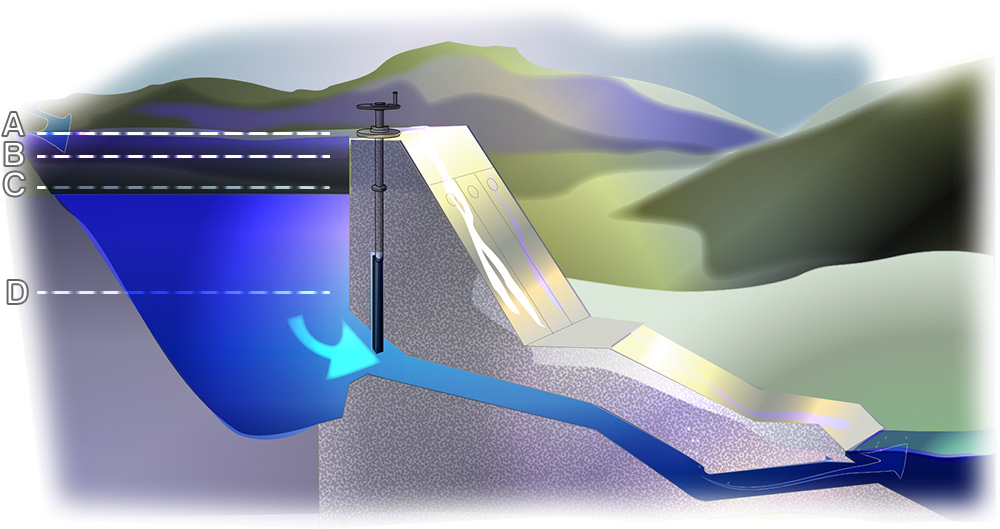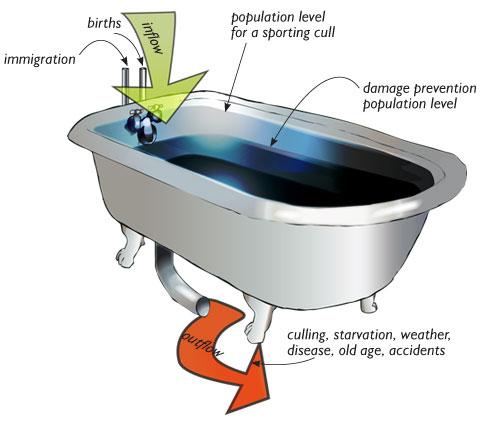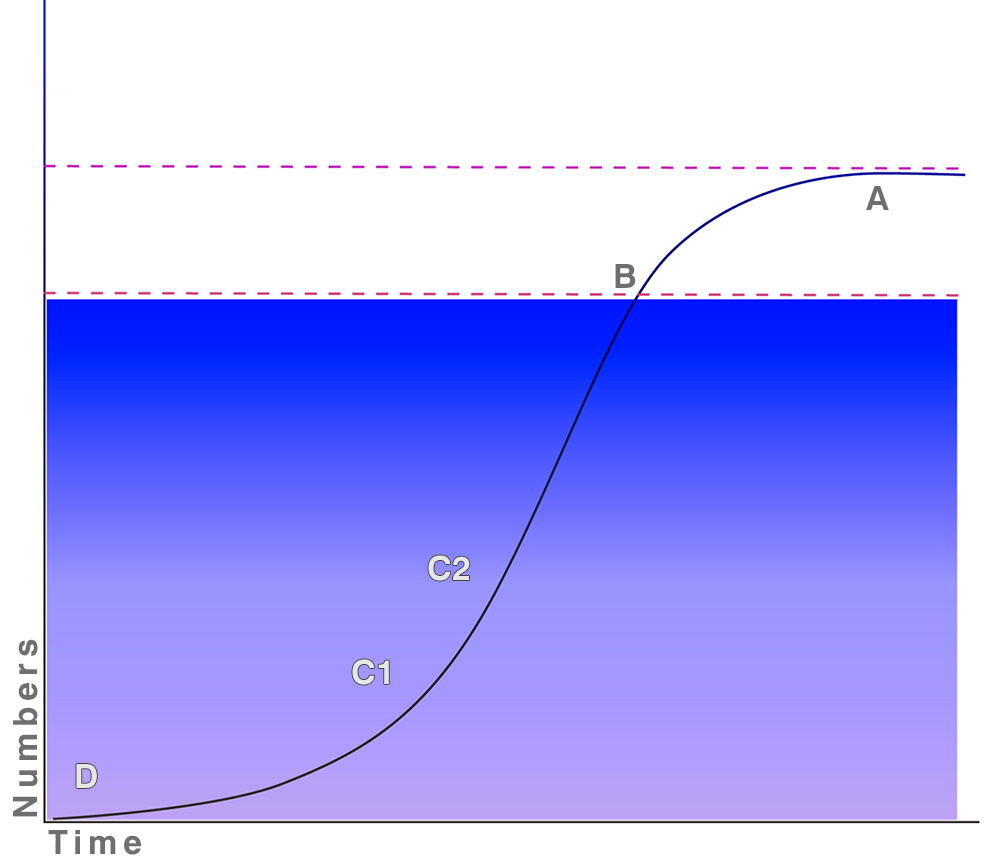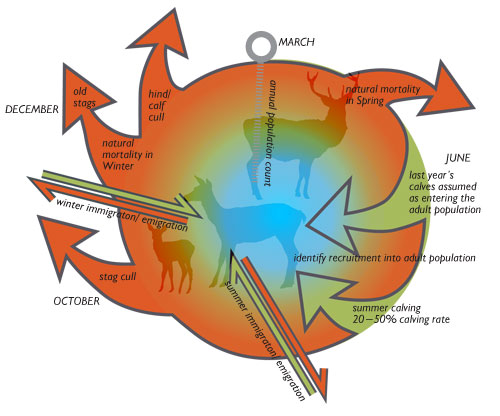Aim
The aim of this guide is to provide information on setting cull targets in order to achieve management objectives. The guide demonstrates how population models are an important element in determining cull targets and describes the basic principles behind setting sporting and damage prevention culls.

the inflow at A denotes births and immigration
The water level “C” represents the current deer population level. While the inflow and outflow are equal the population will be stable, if the inflow exceeds the outflow, the population will rise, if the outflow exceeds the inflow the population will fall. Culling can be regarded as a sluice gate by which the amount of outflow can be varied.
At level “D” numbers are low and habitat resources are abundant, consequently deer mortality is low and recruitment is high. Habitat and deer condition are both good.
As the population rises towards level “B” competition between individuals and habitat impact increases, but at level “B”, the “sustainable carrying capacity” (SCC), the habitat can sustain the deer in good condition throughout the year without further degradation.
If the population reaches “A” ,the “absolute carrying capacity” (ACC), there will be lower recruitment, higher mortality and generally poorer body condition. Emigration/range expansion may increase if the surrounding area is not already saturated. There will be significant impact to the habitat and the original carrying capacity may be reduced (equivalent to the top of the dam wall being eroded).
The bath
(version 2)

fig.1 the bath represents the size of population a particular habitat can hold. The population level is altered by the amount of ‘inflow’ and ‘outflow’. Management objectives will determine the population level to be set.
Population model
A population model can be developed to provide information on the number of deer required to deliver a desired population or sporting cull each year (see Figs 1 & 2). Where the population is greater than desired, a reduction cull will be required to reduce numbers initially. The time taken to implement any reduction cull must be dictated by a realistic assessment of the resources available, manpower in particular. The reduction cull should be carried out over the shortest time that is practically possible.
The model has to assume a ‘closed’ population; that is, a population that is not subject to immigration and emigration. In reality, allowance must be made for any known natural deer movements in and out of the area.
The population model is only as good as the information that is put into it so it is important that information is as accurate as possible.
Models are only tools to help decision making and deer managers need to be aware of the information they do not have just as much as the information they do have. Where assumptions are made it is important to understand how variances affect population dynamics. Population models can vary in complexity depending on the level of information but even in its simplest form modelling is an important tool to aid deer managers.
For a model to work some key information is required:
Estimating the population
- Estimating the number of deer in a population can be done by direct counts or by an indirect method such as dung counts.*
- In dense habitats, direct counting is often not possible and indirect methods must be used, such as dung counting.
Whatever method is used the numbers recorded will only be an estimate of the population. Consistency in the counting technique from year to year is therefore important to ensure the cull model is reflecting real changes and not differing errors in the count.

(top dotted line) absolute carrying capacity; (lower dotted line) denotes sustainable carrying capacity (SCC); B: when numbers are above the SCC, competition between individual deer increases

fig. 2 the population model shows in more detail inflow and outflow factors. By understanding these factors, quantifying them where possible (e.g. population estimates) and manipulating them where relevant (e.g. culling) a desired population level can be achieved.
Establishment of recruitment rates
The accuracy of the model can be improved by collecting local information on recruitment, for example from sample hind:calf ratios in spring counts of deer on open range or from female:juvenile ratios of woodland deer from records of group observations through late winter and spring.
To maintain a stable population, managers should cull at a level which matches recruitment levels to ensure that populations do not increase or decrease, pre-calving.
Level of natural mortality
In managed populations mortality will usually be low depending on the habitat and weather. Occasionally, high mortality will take place in extreme winters even in well managed populations (i.e. particularly prolonged periods of wet weather and if Spring growth comes late). Natural mortality can be assessed by undertaking corpse counts in Spring.
Setting culls to achieve management objectives
Sporting culls
Sporting culls are usually based on the objective of producing a particular number of mature males. Often antler quality and size, or lack of it, is an important selection criteria.
It is best to aim for an equal (male / female) sex ratio. A bias toward males may help optimise the sporting cull, but this policy can lead to overall population reduction in the long term due to insufficient recruitment. Where biased toward females the adult sex ratio should be altered during the first few years of the cull to achieve the required number of males from the minimum number of females. This prevents over population in terms of management objectives set.
Damage prevention culls
It is essential to understand what is responsible for damage before assuming that deer are to blame.**
A target, in terms of acceptable damage, should be determined from the objectives set for the management of the particular habitat.
Where deer are considered to be causing damage to habitats then high culling effort is usually maintained until deer impacts, assessed through habitat monitoring, are considered to be low enough to attain the objectives of the site. In concealing environments such as dense woodland. All deer encountered may be culled until the habitat objectives are achieved.
Where excessive damage is occurring, an estimation of population size provides an indication of the resources required, as well as a means to monitor progress.
Progress in reducing damage is best monitored using both population size and habitat damage. The capacity to support deer without compromising habitat management objectives of the site will vary depending on soil type, aspect and altitude. The presence and number of other herbivores e.g. sheep, must also be taken into account.
Allocating cull targets
Cull target setting can be done on an individual property basis or done through a DMG structure whereby a number of properties collaborate to manage a ranging population. This will best be determined by the habitat in the locality and the deer species being managed.
For red deer on open range, due to the extent of the deer range it is often important that this is done at a DMG scale. This is the key driver for collaborative deer management.
DMGs should first establish overall numbers and densities, as a basis for agreeing their objectives and deciding on overall cull targets.*** Thereafter, the allocation of individual cull targets should be agreed depending upon seasonal dispersion of the deer.
